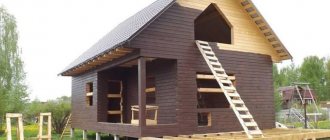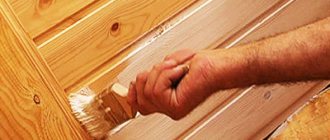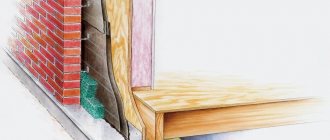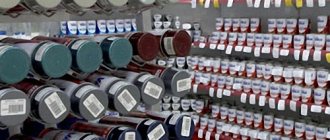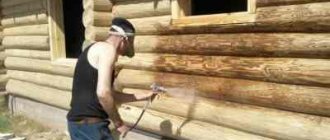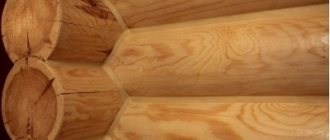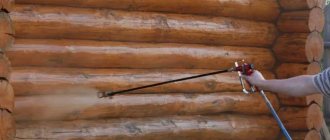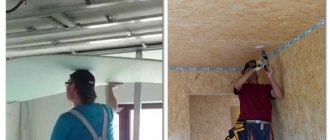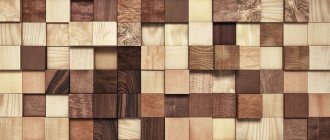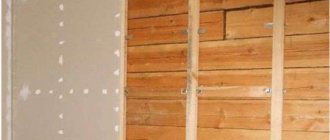Wood is susceptible to the harmful effects of numerous external factors; care should be taken to properly protect the natural building material.
Processing the timber walls upon completion of the construction of the house is the most important stage, without which the work will not be completed.
Why is processing necessary?
Special impregnations are used to color lumber . They contain substances that can protect cottages from the harmful effects of various factors:
- moisture, excessive dryness - getting wet and overdrying harms the wood;
- bioorganisms - pests, fungal infections, mold can destroy the timber;
- fire hazard – fire can be prevented through the use of fire-resistant compounds.
On a note ! Processing walls made of timber allows you to achieve maximum safety, provided that the materials are chosen correctly.
Consequences of absence
Various factors can lead to the destruction of a cottage:
- ultraviolet;
- high humidity, precipitation;
- rodents, insects;
- concentrated acid-base agents;
- fire;
- condensation due to uneven heating of the walls.
The inevitability of the negative influence of the listed factors confirms that the treatment of the facade and internal walls made of timber is necessary.
Basic requirements for compositions
Wood itself is a durable material, however, the service life of wooden structures can be significantly reduced by the following factors:
- moisture – reduces the strength of wood and also promotes the development of microorganisms;
- microorganisms that cause rotting, as well as mold and parasitic insects - destroy the structure;
- changes in temperature and humidity lead to deformation and cracking of wood.
Thus, walls and other wooden surfaces inside the house must first be protected from moisture and biological influences. In addition, it is extremely important to provide fire protection to the tree by treating it with a fire retardant.
Before processing the walls must be thoroughly sanded
But there are other, no less important requirements for compositions:
- must ensure an attractive appearance of the wood, especially if it is not planned to finish the wooden surfaces with other materials;
- environmental friendliness - wood treated with protective compounds should not evaporate toxic substances in residential areas.
Currently, there are many tools that meet these requirements.
How to cover the building after construction?
Coating the surface of the cottage with special compounds protects against humidity, pests, and UV radiation . Most companies do not guarantee the long life of the house if no treatment has been carried out after construction. Before applying the product, you should know that you can use different materials other than linseed oil. It prevents the walls from breathing and causes the wood to rot.
Attention ! Fire retardant and antiseptic agents must penetrate inside the timber, and moisture and light protection agents must create a dense, reliable film. Antiseptics, fire retardants, light-protective compounds and waterproofing can achieve the desired effect.
Outside
When choosing impregnations for treating a timber building from the outside, you need to take into account how the antiseptic will be absorbed by the wood. Water-based products have the best characteristics . Antiseptic and fire retardant compounds must have precisely these qualities. Regarding water- and light-protective agents, they can be anything, even oil-based. They are often used to speed up processing, such as light-conducting materials.
From the inside
Materials with varying degrees of transparency are suitable.
This way you can emphasize the texture of the wood and change the shade. Fire-fighting and antiseptic agents should not change the natural texture of the lumber. Primary and internal processing of a log cottage is done simultaneously. After 14 days, the surface is covered with other finishing and protective materials.
Can be used indoors:
- natural wax (expensive);
- mixture together with salt, slaked lime and water (changes shade);
- oak bark, with flax oil (must be rubbed in well);
- shading and colorless varnish bases (give the surface shine).
Bleaching will help get rid of gray and blue areas . These products contain chlorides and are applied in a thin layer. Walls can be covered with other materials only after 7 days.
Particular attention should be paid to the lower crowns, subfloor, canopy joists and other places located near the base of the building and the ground. They are most susceptible to the harmful effects of moisture and pests. The antiseptic will reliably protect the foundation from destruction.
Which means should I choose?
Manufacturers offer different compositions for covering the walls of a timber house inside and outside. The main thing is that they retain the characteristics of wood and are environmentally friendly. Also, the material should protect the timber from insects and moisture. Decorative characteristics also play an important role.
There are 4 groups of products for external use:
- Antiseptics are absorbed into the wood, increasing its resistance to microorganisms and moisture. Varnish, wax, oils destroy blue stains and mold.
- Fire retardants prevent fire. At high temperatures they form a film on the surface of the walls.
- Impregnations and preservative compounds preserve the structure of the wood: evenness, smoothness, prevent the formation of cracks, and repel water.
- Finishing, protective materials are used to decorate lumber and preserve its appearance. These are varnishes and paints for wood; they protect walls from dirt and fading.
There is no need to use one remedy against fire, insects, rot, or decoration .
They are ineffective and do not achieve the desired result. It is better to use antiseptics, fire retardants, and paint and varnish compositions independently of each other, this way you can achieve the desired effect.
When purchasing a product for treating a house made of timber, the first thing you need to pay attention to is safety and environmental friendliness.
When choosing a composition, you need to carefully read the annotation . It must indicate that the material is intended for interior decoration. Many manufacturers describe in detail what substances are included in the composition.
For rooms it is better to use water-based impregnations. They have no odor, do not contain toxic components, and are completely safe for humans.
Important ! Regardless of the type of coating, they can only be used for their intended purpose if they are suitable for treating interior spaces. This information is always indicated on the packaging.
What should the interior design look like inside the house?
The layout of the premises should correspond to the tastes of the owner. Some people believe that a wooden house is created only for comfort and coziness, so that it has all communications, so that various utility rooms are built.
Some people consider a country house the best expression of their solidity. However, the environmental friendliness of the home and the individual microclimate of the premises will always remain a priority aspect. Any owner always strives for fashionable and functional design of the interior of a wooden house.
Detailed diagram of installation of double-glazed windows in a wooden house.
When designing a building, you need to determine exactly where the windows will be located, what size they will be, and how many they will be. Installation of modern double-glazed windows will create a modern look for the building and will help minimize heat loss. The layout of the interior of the house greatly depends on the number of residents and their preferences.
Many owners of wooden houses make offices, equip gyms and libraries. To save useful space, they use the attic, where they make a children's room, a bedroom, and set up a workshop.
To preserve the unique atmosphere of the constructed attic, good natural lighting is required. In this regard, special attention should be paid to windows when designing a room. The highlight of the house can be the slope of the attic walls; it will give the room originality and uniqueness.
The interior of a wooden house can be decorated in different ways, perhaps it will be classicism or avant-garde. This issue can be resolved by consulting with an experienced designer. You can, of course, bring your own extraordinary idea to life.
Process Rules
The first work is carried out before the construction of the house. The logs are immersed in an antiseptic. But basically, the wood is processed during manufacturing. If the cottage will not be built immediately after the lumber is delivered, then proper storage must be ensured. The tree should be stored in a ventilated area where there is no dampness or under a canopy, away from the ground.
Secondary wall treatment is done within 2-3 days upon completion of the work. For this purpose, water-soluble agents are used that do not interfere with the natural shrinkage of lumber. Finishing is carried out at a temperature of at least 5-7 degrees . If a house made of timber is being built in the winter, processing can only be done in the spring.
Once shrinkage is complete, a final coating is applied. The time it takes to complete the work depends on the moisture content of the timber and its type. Kiln-dried lumber can be processed immediately after the construction of the cottage is completed. From profiled timber after 1-1.5 years, when the moisture concentration reaches 20%.
How to treat a new house made of timber: first treatment
First of all, antiseptics. These are special products that penetrate deep into the wood and destroy harmful microorganisms, mold spores, fungi, and so on.
The first treatment of the walls should be carried out two weeks after the construction of the log house. If you built a house in winter, then the treatment is carried out immediately as soon as the air temperature rises to +15°C, although there are products that can be used at sub-zero temperatures. But since bacteria and fungi do not develop during frost, treatment in this case is not so necessary.
Instructions
Facade work is carried out in several stages.
Outside
Work is performed in the following sequence:
- 2 weeks after completion of construction, the external walls are coated with an antiseptic or fire retardants; fire-retardant compounds can be used.
The treatment is carried out in several stages, the antiseptic is applied in two layers. If the house was built in winter, then you need to wait until the temperature rises to +10 degrees.Next comes impregnation using a spray gun. But this protection will only last for 5 months.
- 5 months after the first coating with a fire retardant and antiseptic, they proceed to finishing treatment, which will protect against pests, rot, and preserve the first layer.
Advice ! It is recommended to treat a house made of timber every 4 years, this will preserve the original properties of the wood and extend the life of the structure.
Inside
Water-based compounds are used indoors. Internal work is carried out together with facade finishing . After 2 weeks the final coating is done.
To do this you will need:
- thin brush;
- natural bristles;
- final varnish coating.
If gray or black spots appear, they need to be covered with chloride-based wood protectants. The affected areas are covered with the composition, after 2-3 minutes the timber acquires a natural shade.
Conclusion
Currently, the building materials market offers a wide range of wood protective compounds that can be used for interior work. Therefore, when choosing how to treat timber inside a house, you should first decide on the design of the premises and the method of finishing surfaces.
You can get additional useful information on the topic discussed above from the video in this article.
Houses made of timber have many undeniable advantages. But despite this, they require proper care.
Wood is susceptible to the harmful effects of numerous external factors; care should be taken to properly protect the natural building material.
Processing the timber walls upon completion of the construction of the house is the most important stage, without which the work will not be completed.
What should you pay attention to?
When preparing to paint timber, you need to take into account the texture and quality of the lumber and the purpose of the building . It is necessary that the treatment achieves the desired effect:
- thin film so as not to interfere with air circulation;
- the surface is protected from precipitation and humidity;
- timber is not exposed to fungi, mold, ultraviolet radiation;
- the risk of fire is minimal.
Owners of log cottages should not forget that the use of numerous means can lead to negative consequences; they have mutually exclusive properties. Professionals recommend: buying universal biological and fire protection materials. Use dyes against ultraviolet radiation. Buy varnishes for timber that are water-based.
Approximate costs
The cost of services in Russia ranges from 30 to 450 rubles per m2 . The price depends on the type of processing, materials used, volumes.
The best tools for the job will cost:
| Brand | Description | Price |
| Senezh | Sustainable, high-class products, including renewing and whitening materials, antiseptics for cottages, baths, gazebos, protect well from humidity, insects, and fire. Extends the service life of the building by 10 years. Made in Russia. | from 390 rubles (5 kg) |
| Belinka | Eco-friendly, natural, effective compositions protect wood from moisture, ultraviolet radiation, fire, and pests. The products are presented in a wide range. Manufacturer Slovenia. | from 410 rubles (1 liter) |
| Pinotex | Polymer solutions protect against humidity, mold, mildew, pests, and temperature fluctuations. Excellent for outdoor use. Made in Estonia. | from 290 rubles (1 liter) |
| Neomid | Highly effective impregnation for cottages, wooden floors, baths. Protects against moisture for 5-6 years. There are materials for covering the ends. An excellent combination of cost and quality. Manufacturer Russia. | from 210 rubles (1 liter) |
| Tikkurila | Moisture-resistant coatings create a protective thin film. They protect against precipitation and have many positive characteristics. Produced in Finland. | from 260 rubles (1 liter) |
| Aquatex | It is produced in the form of impregnation, primer, tinted and colorless. 15 shade options, prevents the formation of fungus, prevents the harmful effects of humidity, ultraviolet radiation, used for middle-class wood. Manufactured in Russia. | from 210 rubles (1 liter) |
| Sitex | It is used for different types of wood, protects the timber from moisture, and maintains the original appearance of the house for 10 years. There are tinted (12 shades) and colorless options. Manufactured in Russia. | from 200 rubles (1 liter) |
This is the approximate cost of materials, it all depends on the type of product and volume. The price of services is also calculated individually.
